WEEK 1
7 - 13 JUN
We had an online meeting with Mentors and decided split the project in two main areas:
- Machine Learning algorythm using TensorFlow, deploying by Tarun
- Server work and connectivity between the code and the Aztec glyphs app hosted in Uni. Oregon’s servers (by me)
We have decided if we could have a functional prototype before the mid evaluation project.
Then, a local copy of all glyphs hosted in the Web app was provided by Stephanie for a first review. I get in contact with the server system admin Len for specifications and evaluating the best way for server connection without compromise data or files. All the project work would be dumped in U. Oregon’s server.
The main concept for the project is:
- Integrate a form or end-user webpage for upload images.
- Provide images to the prototype via API.
- A prototype working with CPU (non-GPU).
- The result of prediction comes back to the user via webpage
- New user images are stored in filesystem.
WEEK 2
14 - 20 JUN
I was in contact with Len, U. Oregon Admin Server for further specifications. We need to deploy a development environment as follows:
- Create a Virtual Machine with 2 cores and 4 GB RAM.
- RedHat 7 Enterprise or CentOS for a non-GPU enviroment as OS.
- Do not reach more than 40 GB of virtual disk availability.
An initial Machine Learning protype via Google Colab was provided for the team by Tarun.
WEEK 3
21 - 27 JUN
At this point and reviewed glyphs labels and storage, I started to do:
- Create a couple of VM with CentOS 7 and Ubuntu 20.4, just in case.
- Config a LAMP (Linux-Apache-MySQL-PHP) in them
- Install and config Drupal 8/9 structure for image info stored in the DB (MariaDB)
STARTING POINT:
VM: 2 cores; 4 GB RAM; 40 GB HD
Build Operating System (CentOS 7): 3.10.0-957.1.3.el7.x86_64
Root & adminuser accounts
- Pre-commands:
sudo yum update
reboot
CONFIG LAMP (as adminuser)
- MariaDB 10.5
sudo rpm --import /etc/pki/rpm-gpg/RPM-GPG-KEY*
sudo yum -y install epel-release
sudo tee /etc/yum.repos.d/MariaDB.repo<<EOF
[mariadb]
name = MariaDB
baseurl = http://yum.mariadb.org/10.5/centos7-amd64
gpgkey=https://yum.mariadb.org/RPM-GPG-KEY-MariaDB
gpgcheck=1
EOF
sudo yum makecache fast
sudo yum -y install MariaDB-server MariaDB-client
sudo systemctl start mariadb
sudo systemctl enable mariadb
sudo mysql_secure_installation
/* set root pwd & enable root authentication */
- PHP 7.3.29
sudo yum -y install httpd
sudo systemctl start httpd.service
sudo systemctl enable httpd.service
sudo firewall-cmd --permanent --zone=public --add-service=http
sudo firewall-cmd --permanent --zone=public --add-service=https
sudo firewall-cmd --reload
sudo rpm -Uvh http://rpms.remirepo.net/enterprise/remi-release-7.rpm
sudo yum -y install yum-utils
sudo yum-config-manager --enable remi-php73
sudo yum -y install php php-opcache
sudo systemctl restart httpd.service
sudo yum -y install php-mysqlnd php-pdo
sudo yum -y install php-gd php-ldap php-odbc php-pear php-xml php-xmlrpc php-mbstring php-soap curl curl-devel
sudo systemctl restart httpd.service
- PHPMyAdmin 4.4.15.10
yum -y install phpMyAdmin
vi /etc/httpd/conf.d/phpMyAdmin.conf
/* replace:
# Apache 2.4
# <RequireAny>
# Require ip 127.0.0.1
# Require ip ::1
# </RequireAny>
Require all granted
*/
systemctl restart httpd.service
- DRUPAL 9.2.1
sudo yum install -y policycoreutils-python wget
sudo wget --content-disposition https://www.drupal.org/download-latest/tar.gz
sudo tar xf drupal-9.2.1.tar.gz -C /var/www/html/
sudo mv /var/www/html/drupal-9.2.1/ /var/www/html/aztecglyphs
sudo chown -R apache: /var/www/html/aztecglyphs/sites/default/
sudo semanage fcontext -a -t httpd_sys_rw_content_t "/var/www/html/aztecglyphs/sites/default(/.*)?"
sudo restorecon -R /var/www/html/aztecglyphs/sites/default/
sudo yum install -y php-pecl-apcu php-gd php-mbstring php-opcache php-pecl-uploadprogress php-xml
sudo yum install -y php-mysqlnd
sudo systemctl reload httpd
sudo vi /etc/httpd/conf.d/aztecglyphs.conf
/* add:
<Directory /var/www/html/aztecglyphs>
AllowOverride all
</Directory>
*/
sudo systemctl reload httpd
WEEK 4
28 JUN - 4 JUL
This week I would prepare the structure of folders and DB objects, as in U. Oregon server
- The glyph images are hosted in /var/www/html/aztecglyphs/sites/default/files
- More accurated new glyphs was provided by Stephanie as a ZIP.
- I create a new database labeled: aztecglyphs
- I create the table for images info stored, labeled: file_managed
CREATE AZTECGLYPH DB
mysql -u root -p
MariaDB> create database aztecglyphs charset utf8mb4 collate utf8mb4_unicode_ci;
MariaDB> create user aztecglyphs@localhost identified by 'pwd';
MariaDB> exit
Open http://localhost/aztecglyphs
- Set “Standar” installation
- DB name: aztecglyphs
- DB user: aztecglyphs
- DB pwd: ‘pwd’
Next step:
- Set Site name: aztecglyphs
- Site email: aztecglyphs@localhost
- Admin user: aztecadmin
- Admin pwd: ‘pwd’

LOAD NEW GLYPH IMAGES IN DRUPAL FOLDER
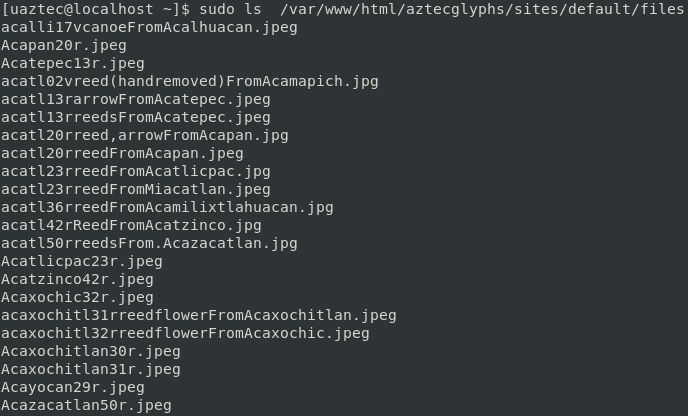
CREATE TABLE FOR FILE METADATA
mysql -u root -p
MariaDB> use aztecglyphs
MariaDB> CREATE TABLE IF NOT EXISTS `file_managed` (
`fid` int(10) unsigned NOT NULL COMMENT 'File ID.',
`uid` int(10) unsigned NOT NULL DEFAULT '0' COMMENT 'The users.uid of the user who is associated with the file.',
`filename` varchar(255) NOT NULL DEFAULT '' COMMENT 'Name of the file with no path components. This may differ from the basename of the URI if the file is renamed to avoid overwriting an existing file.',
`uri` varchar(255) CHARACTER SET utf8 COLLATE utf8_bin NOT NULL DEFAULT '' COMMENT 'The URI to access the file (either local or remote).',
`filemime` varchar(255) NOT NULL DEFAULT '' COMMENT 'The file’s MIME type.',
`filesize` bigint(20) unsigned NOT NULL DEFAULT '0' COMMENT 'The size of the file in bytes.',
`status` tinyint(4) NOT NULL DEFAULT '0' COMMENT 'A field indicating the status of the file. Two status are defined in core: temporary (0) and permanent (1). Temporary files older than DRUPAL_MAXIMUM_TEMP_FILE_AGE will be removed during a cron run.',
`timestamp` int(10) unsigned NOT NULL DEFAULT '0' COMMENT 'UNIX timestamp for when the file was added.',
`type` varchar(50) NOT NULL DEFAULT 'undefined' COMMENT 'The type of this file.'
) ENGINE=InnoDB DEFAULT CHARSET=utf8 COMMENT='Stores information for uploaded files.';
MariaDB> ALTER TABLE `file_managed` ADD PRIMARY KEY (`fid`), ADD UNIQUE KEY `uri` (`uri`), ADD KEY `uid` (`uid`), ADD KEY `status` (`status`), ADD KEY `timestamp` (`timestamp`), ADD KEY `file_type` (`type`);
/*
Indexes for dumped tables
Indexes for table `file_managed`
*/
MariaDB> ALTER TABLE `file_managed` MODIFY `fid` int(10) unsigned NOT NULL AUTO_INCREMENT COMMENT 'File ID.';
/*
AUTO_INCREMENT for dumped tables
AUTO_INCREMENT for table `file_managed`
*/
MariaDB> exit
WEEK 5
5 - 11 JUL
This week I am going to import the updated model provided by Tarun.
- Install Python 3.7 (or Miniconda3-py39) and neccesary libraries used by ML model.
- Export Colab notebook and import to Jupyter notebook.
- Have a success import Machine Learning model to the VM filesystem.
- Test if running is OK.
PYTHON 3.7
sudo yum install gcc openssl-devel bzip2-devel libffi-devel zlib-devel
cd /usr/src
sudo wget https://www.python.org/ftp/python/3.7.9/Python-3.7.9.tgz
sudo tar xzf Python-3.7.9.tgz
cd Python-3.7.9
sudo ./configure --enable-optimizations
sudo make altinstall
sudo rm /usr/src/Python-3.7.9.tgz
alias python3='/usr/local/bin/python3.7'
alias pip='/usr/local/bin/pip3.7'
TENSORFLOW 2.3
cd $HOME
python3 -m ensurepip
python3 -m venv --system-site-packages ./venv
source ./venv/bin/activate
(venv)$ pip install --upgrade pip
(venv)$ pip install tensorflow==2.3.0
(venv)$ python3 -c "import tensorflow as tf;print(tf.reduce_sum(tf.random.normal([1000, 1000])))"
(venv)$ deactivate
IMPORT MOBILENET PROTOTYPE
https://colab.research.google.com/drive/1rUA51e5Wz-VxsuNOXkfwIcD8PPasXMAG?usp=sharing
WEEK 6 (First Evaluation)
12 - 18 JUL
INSTALLING KERAS 2.4 AND LIBRARIES
pip install keras==2.4
pip install pillow
pip install matplotlib
pip install opencv-python
- Create directory for user uploads (temporally as 777)
sudo mkdir /var/www/html/aztecglyphs/sites/default/useruploads
sudo chown apache:apache /var/www/html/aztecglyphs/sites/default/useruploads
sudo chmod 777 /var/www/html/aztecglyphs/sites/default/useruploads
- MOBILENET_AZTECPLYPHS.PY
Downloaded from Colab via Save as .py and place in $HOME/Downloads (temporally)
adapt code to local filesystem
# -*- coding: utf-8 -*-
"""MobileNet2.ipynb
Automatically generated by Colaboratory.
Original file is located at
https://colab.research.google.com/drive/1rUA51e5Wz-VxsuNOXkfwIcD8PPasXMAG
"""
# Comment googledrive (now it's local)
#from google.colab import drive
#drive.mount('/content/drive/')
# Path of the input image.
path='/var/www/html/aztecglyphs/sites/default/useruploads/example.jpg'
result_path='/var/www/html/aztecglyphs/sites/default/useruploads/result.jpg'
import os
import keras
from keras.preprocessing import image
from keras.applications.imagenet_utils import decode_predictions, preprocess_input
from keras.models import Model
import numpy as np
import tensorflow as tf
base_models=tf.keras.applications.MobileNet()
def load_image(path):
img = image.load_img(path, target_size=base_models.input_shape[1:3])
x = image.img_to_array(img)
x = np.expand_dims(x, axis=0)
x = preprocess_input(x)
return img, x
feat_extractor = Model(inputs=base_models.input, outputs=base_models.get_layer("reshape_2").output)
# Just set this path to the path of the directory where dataset is stored.
images_path = '/var/www/html/aztecglyphs/sites/default/files'
image_extensions = ['.jpg', '.png', '.jpeg']
max_num_images = 10000
images = [os.path.join(dp, f) for dp, dn, filenames in os.walk(images_path) for f in filenames if os.path.splitext(f)[1].lower() in image_extensions]
if max_num_images < len(images):
images = [images[i] for i in sorted(random.sample(xrange(len(images)), max_num_images))]
print("keeping %d images to analyze" % len(images))
import time
tic = time.clock()
features = []
for i, image_path in enumerate(images):
if i % 500 == 0:
toc = time.clock()
elap = toc-tic;
print("analyzing image %d / %d. Time: %4.4f seconds." % (i, len(images),elap))
tic = time.clock()
img, x = load_image(image_path);
feat = feat_extractor.predict(x)[0]
features.append(feat)
print('finished extracting features for %d images' % len(images))
##Enter Path here
img, x = load_image(path);
imga = feat_extractor.predict(x)[0]
from scipy.spatial import distance
def get_closest_images1(imga, num_results=5):
distances = [ distance.cosine(imga, feat) for feat in features ]
idx_closest = sorted(range(len(distances)), key=lambda k: distances[k])[1:num_results+1]
return idx_closest
def get_concatenated_images(indexes, thumb_height):
thumbs = []
for idx in indexes:
img = image.load_img(images[idx])
img = img.resize((int(img.width * thumb_height / img.height), thumb_height))
thumbs.append(img)
concat_image = np.concatenate([np.asarray(t) for t in thumbs], axis=1)
return concat_image
results_image = get_concatenated_images(get_closest_images1(imga), 200)
import matplotlib.pyplot as plt
import cv2
import matplotlib.pyplot as plt
r=cv2.imread(path)
result=cv2.imwrite(result_path, results_image)
if result==True:
print('File saved successfully')
else:
print('Error in saving file')
plt.imshow(r)
plt.figure(figsize = (16,12))
plt.imshow(results_image)
- File to compare and run the python script
sudo cp /var/www/html/aztecglyphs/sites/default/files/Xico20vSIMPLEX.jpg /var/www/html/aztecglyphs/sites/default/useruploads/example.jpg
python3 $HOME/Downloads/mobilenet_aztecglyphs.py
- Console OUTPUT
[uaztec@localhost Downloads]$ python3 /home/uaztec/Downloads/mobilenet_aztecglyphs.py
2021-07-16 03:25:27.081482: W tensorflow/stream_executor/platform/default/dso_loader.cc:59] Could not load dynamic library 'libcudart.so.10.1'; dlerror: libcudart.so.10.1: cannot open shared object file: No such file or directory
2021-07-16 03:25:27.081504: I tensorflow/stream_executor/cuda/cudart_stub.cc:29] Ignore above cudart dlerror if you do not have a GPU set up on your machine.
Using TensorFlow backend.
2021-07-16 03:25:27.843362: W tensorflow/stream_executor/platform/default/dso_loader.cc:59] Could not load dynamic library 'libcuda.so.1'; dlerror: libcuda.so.1: cannot open shared object file: No such file or directory
2021-07-16 03:25:27.843386: W tensorflow/stream_executor/cuda/cuda_driver.cc:312] failed call to cuInit: UNKNOWN ERROR (303)
2021-07-16 03:25:27.843411: I tensorflow/stream_executor/cuda/cuda_diagnostics.cc:156] kernel driver does not appear to be running on this host (localhost.localdomain): /proc/driver/nvidia/version does not exist
2021-07-16 03:25:27.843571: I tensorflow/core/platform/cpu_feature_guard.cc:142] This TensorFlow binary is optimized with oneAPI Deep Neural Network Library (oneDNN)to use the following CPU instructions in performance-critical operations: AVX2
To enable them in other operations, rebuild TensorFlow with the appropriate compiler flags.
2021-07-16 03:25:27.848319: I tensorflow/core/platform/profile_utils/cpu_utils.cc:104] CPU Frequency: 2904000000 Hz
2021-07-16 03:25:27.848468: I tensorflow/compiler/xla/service/service.cc:168] XLA service 0x4f28fd0 initialized for platform Host (this does not guarantee that XLA will be used). Devices:
2021-07-16 03:25:27.848481: I tensorflow/compiler/xla/service/service.cc:176] StreamExecutor device (0): Host, Default Version
keeping 1261 images to analyze
/home/uaztec/Downloads/mobilenet_aztecglyphs.py:44: DeprecationWarning: time.clock has been deprecated in Python 3.3 and will be removed from Python 3.8: use time.perf_counter or time.process_time instead
tic = time.clock()
/home/uaztec/Downloads/mobilenet_aztecglyphs.py:48: DeprecationWarning: time.clock has been deprecated in Python 3.3 and will be removed from Python 3.8: use time.perf_counter or time.process_time instead
toc = time.clock()
analyzing image 0 / 1261. Time: 0.0000 seconds.
/home/uaztec/Downloads/mobilenet_aztecglyphs.py:51: DeprecationWarning: time.clock has been deprecated in Python 3.3 and will be removed from Python 3.8: use time.perf_counter or time.process_time instead
tic = time.clock()
analyzing image 500 / 1261. Time: 24.9500 seconds.
analyzing image 1000 / 1261. Time: 24.8900 seconds.
finished extracting features for 1261 images
File saved successfully
Folder OUTPUT
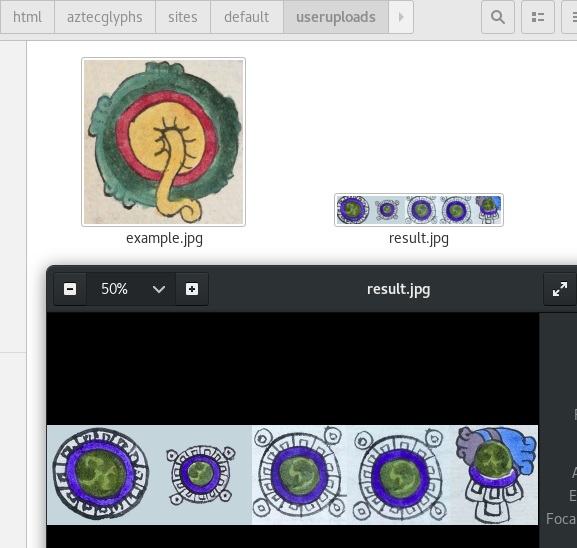
- CREATE AN UPLOAD FORM (via PHP)
sudo vi /var/www/html/aztecglyphs/upload.html
<!DOCTYPE html>
<html>
<body>
<form action="upload.php" method="post" enctype="multipart/form-data">
Select image to upload:
<input type="file" name="fileToUpload" id="fileToUpload">
<input type="submit" value="Upload Image" name="submit">
</form>
</body>
</html>
sudo vi /var/www/html/aztecglyphs/upload.php
<?php
$target_dir = "/var/www/html/aztecglyphs/sites/default/useruploads/";
$target_file = $target_dir . basename($_FILES["fileToUpload"]["name"]);
$uploadOk = 1;
$imageFileType = strtolower(pathinfo($target_file,PATHINFO_EXTENSION));
// Check if image file is a actual image or fake image
if(isset($_POST["submit"])) {
$check = getimagesize($_FILES["fileToUpload"]["tmp_name"]);
if($check !== false) {
echo "File is an image - " . $check["mime"] . ".";
$uploadOk = 1;
} else {
echo "File is not an image.";
$uploadOk = 0;
}
}
// Check if file already exists
if (file_exists($target_file)) {
echo "Sorry, file already exists.";
$uploadOk = 0;
}
// Check file size
if ($_FILES["fileToUpload"]["size"] > 500000) {
echo "Sorry, your file is too large.";
$uploadOk = 0;
}
// Allow certain file formats
if($imageFileType != "jpg" && $imageFileType != "png" && $imageFileType != "jpeg"
&& $imageFileType != "gif" ) {
echo "Sorry, only JPG, JPEG, PNG & GIF files are allowed.";
$uploadOk = 0;
}
// Check if $uploadOk is set to 0 by an error
if ($uploadOk == 0) {
echo "Sorry, your file was not uploaded.";
// if everything is ok, try to upload file
} else {
if (move_uploaded_file($_FILES["fileToUpload"]["tmp_name"], $target_file)) {
echo "The file ". htmlspecialchars( basename( $_FILES["fileToUpload"]["name"])). " has been uploaded.";
} else {
echo "Sorry, there was an error uploading your file.";
}
}
?>
- Basic Upload Form

- Choose a file
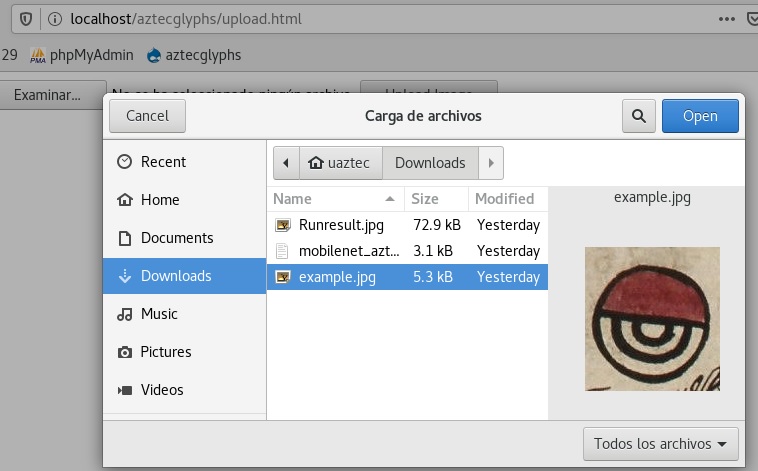
- Select “Upload Image”

- File upload success

- Check if it was uploaded
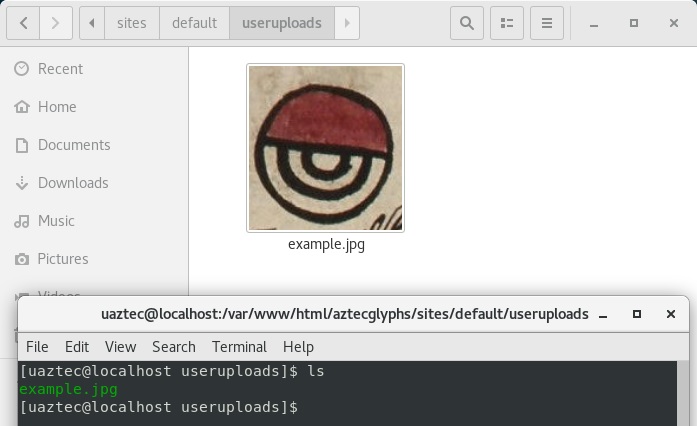
- Now, run the python script manually (temporally)
python3 $HOME/Downloads/mobilenet_aztecglyphs.py
The RESULT is in the same folder

- Now, let’s change upload.html as in Visual Lexicon site
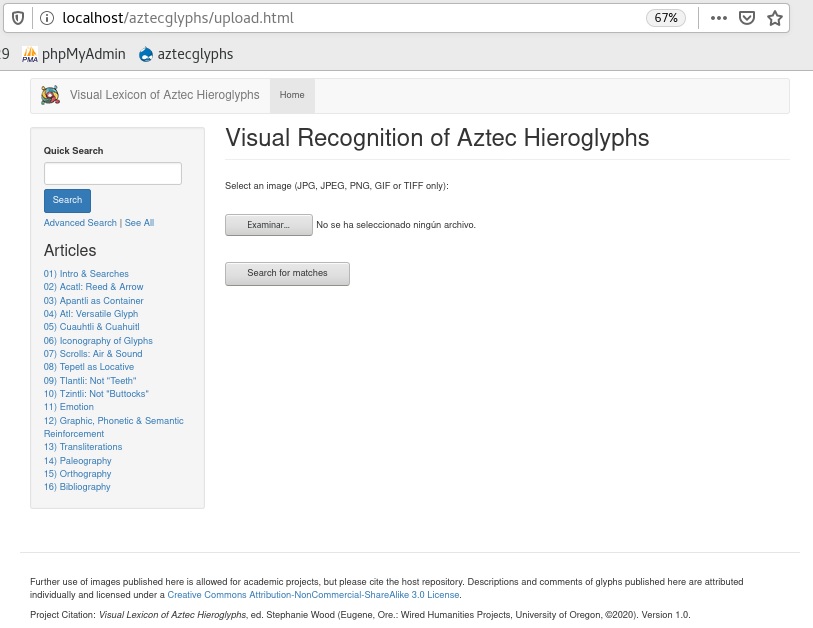
WEEK 7
19 - 25 JUL
This week I’m going to edit python script for generate itself a ‘result.html’ with glyphs path & get name from filename info.
- MOBILENET_AZTECPLYPHS.PY
adapt code for generate itself a ‘result.html’ file
#!/usr/bin/python
# -*- coding: utf-8 -*-
"""MobileNet2.ipynb
Automatically generated by Colaboratory.
Original file is located at
https://colab.research.google.com/drive/1rUA51e5Wz-VxsuNOXkfwIcD8PPasXMAG
"""
# Path of the input image.
path='/var/www/html/aztecglyphs/sites/default/useruploads/example'
result_path='/var/www/html/aztecglyphs/sites/default/useruploads/result.jpg'
import os
import keras
from keras.preprocessing import image
from keras.applications.imagenet_utils import decode_predictions, preprocess_input
from keras.models import Model
import numpy as np
import re
import tensorflow as tf
base_models=tf.keras.applications.MobileNet()
def load_image(path):
img = image.load_img(path, target_size=base_models.input_shape[1:3])
x = image.img_to_array(img)
x = np.expand_dims(x, axis=0)
x = preprocess_input(x)
return img, x
feat_extractor = Model(inputs=base_models.input, outputs=base_models.get_layer("reshape_2").output)
# Just set this path to the path of the directory where dataset is stored.
images_path = '/var/www/html/aztecglyphs/sites/default/files'
image_extensions = ['.jpg', '.png', '.jpeg', '.gif', '.tiff']
max_num_images = 10000
images = [os.path.join(dp, f) for dp, dn, filenames in os.walk(images_path) for f in filenames if os.path.splitext(f)[1].lower() in image_extensions]
images_website = [os.path.join('/aztecglyphs/sites/default/files', f) for dp, dn, filenames in os.walk(images_path) for f in filenames if os.path.splitext(f)[1].lower() in image_extensions]
if max_num_images < len(images):
images = [images[i] for i in sorted(random.sample(xrange(len(images)), max_num_images))]
print("keeping %d images to analyze" % len(images))
import time
tic = time.clock()
features = []
for i, image_path in enumerate(images):
if i % 500 == 0:
toc = time.clock()
elap = toc-tic;
print("analyzing image %d / %d. Time: %4.4f seconds." % (i, len(images),elap))
tic = time.clock()
img, x = load_image(image_path);
feat = feat_extractor.predict(x)[0]
features.append(feat)
print('finished extracting features for %d images' % len(images))
##Enter Path here
img, x = load_image(path);
imga = feat_extractor.predict(x)[0]
from scipy.spatial import distance
def get_closest_images1(imga, num_results=5):
distances = [ distance.cosine(imga, feat) for feat in features ]
idx_closest = sorted(range(len(distances)), key=lambda k: distances[k])[1:num_results+1]
return idx_closest
import sys
original_stdout=sys.stdout
# Creating result.html with user img first
with open('/var/www/html/aztecglyphs/result.html','w') as f:
sys.stdout = f
print('<!DOCTYPE html><html><head><style>')
print('* {')
print('box-sizing:border-box;')
print('}')
print('.column {')
print(' float:left;')
print(' width:100;')
print(' padding:5px;')
print('}')
print('.row::after {')
print(' content:"";')
print(' clear:both;')
print(' display:table;')
print('}')
print('</style></head><body>')
print('<p>This is your uploaded image:</p>')
print('<div class="row"><img src="/aztecglyphs/sites/default/useruploads/example" alt="" height="200"></div>')
print('<br><p>And these are the 5 most accurate glyphs by the moment:</p>')
print('<div class="row">')
sys.stdout=original_stdout
# each image matched, add file url and split glyphname (first part of the filename)
def get_concatenated_images(indexes, thumb_height):
thumbs = []
for idx in indexes:
with open ('/var/www/html/aztecglyphs/result.html','a') as f:
sys.stdout=f
print('<div class="column"><img src="',images_website[idx],'" alt="" height="120">')
head, tail=os.path.split(images_website[idx])
result = re.split('[0-9]|[.]', tail, maxsplit=1)
print('<p style="text-align:center;">',result[0],'</p></div>')
sys.stdout=original_stdout
img = image.load_img(images[idx])
img = img.resize((int(img.width * thumb_height / img.height), thumb_height))
thumbs.append(img)
concat_image = np.concatenate([np.asarray(t) for t in thumbs], axis=1)
return concat_image
results_image = get_concatenated_images(get_closest_images1(imga), 200)
import matplotlib.pyplot as plt
import cv2
import matplotlib.pyplot as plt
r=cv2.imread(path)
# close the html
result=cv2.imwrite(result_path, results_image)
with open('/var/www/html/aztecglyphs/result.html','a') as f:
sys.stdout = f
print('</div></body></html>')
sys.stdout=original_stdout
And this is all the process result
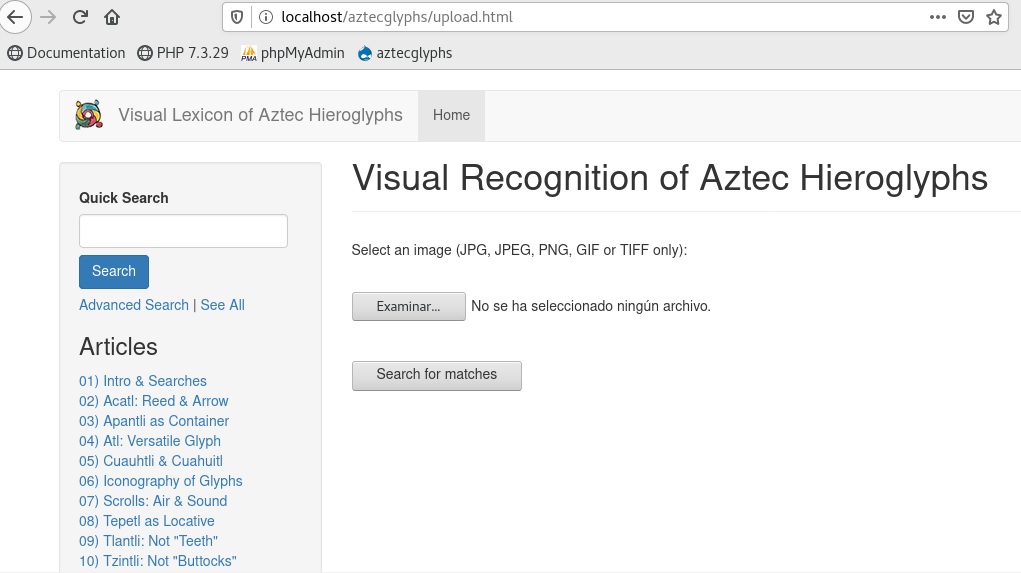
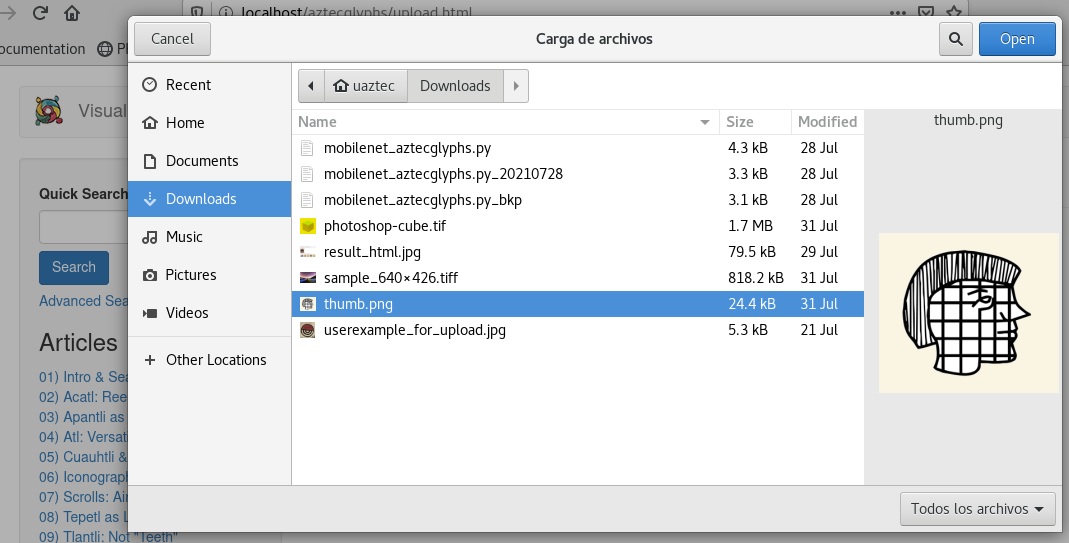
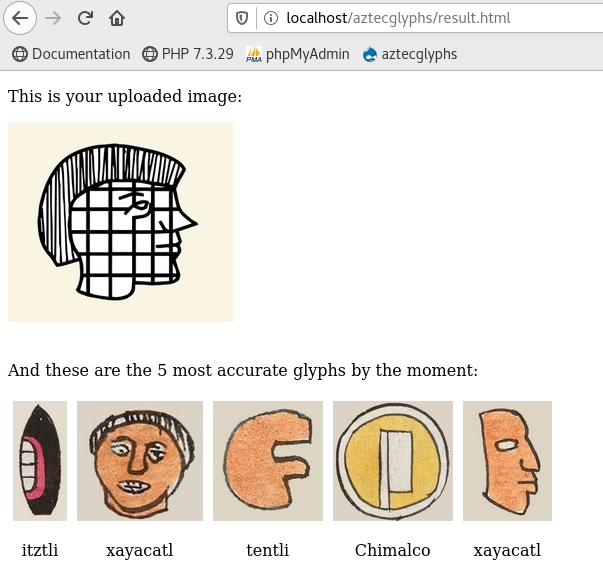
This is local result.html
<!DOCTYPE html><html><head><style>
* {
box-sizing:border-box;
}
.column {
float:left;
width:100;
padding:5px;
}
.row::after {
content:"";
clear:both;
display:table;
}
</style></head><body>
<p>This is your uploaded image:</p>
<div class="row"><img src="/aztecglyphs/sites/default/useruploads/example" alt="" height="200"></div>
<br><p>And these are the 5 most accurate glyphs by the moment:</p>
<div class="row">
<div class="column"><img src=" /aztecglyphs/sites/default/files/itztli30robsidianknifeFromTzihuinquilocan.jpeg " alt="" height="120">
<p style="text-align:center;"> itztli </p></div>
<div class="column"><img src=" /aztecglyphs/sites/default/files/xayacatl13vfaceFromQuauhixayacatitlan.jpeg " alt="" height="120">
<p style="text-align:center;"> xayacatl </p></div>
<div class="column"><img src=" /aztecglyphs/sites/default/files/tentli51rlipFromAtenco.png " alt="" height="120">
<p style="text-align:center;"> tentli </p></div>
<div class="column"><img src=" /aztecglyphs/sites/default/files/Chimalco23r.jpeg " alt="" height="120">
<p style="text-align:center;"> Chimalco </p></div>
<div class="column"><img src=" /aztecglyphs/sites/default/files/xayacatl46rfaceSIMPLEXforXayaco.png " alt="" height="120">
<p style="text-align:center;"> xayacatl </p></div>
</div></body></html>
Success!!
WEEK 8
26 JUL - 1 AUG
This week I’m going to make a fresh install of python3.9 version, use only needed libraries and adapt code to communicate with JS Socket and run python Mobilenet via FLASK
sudo wget https://www.python.org/ftp/python/3.9.5/Python-3.9.5.tgz
sudo mv Python-3.9.5,tgz /usr/lib64
cd /usr/lib64
sudo tar xvf Python-3.9.5.tgz
sudo ./configure --enable-optimizations
sudo make altinstall
sudo alias python3=python3.9
sudo python3 -m ensurepip
sudo python3 -m venv --system-site-packages ./env
sudo source ./env/bin/activate
(env)$ pip install --upgrade pip
(env)$ pip3 install tensorflow==2.3.0
- Now I am going to create folder structure for API.
PATH: /var/www/html/aztecglyphs/
rename python file
./aztecglyphsrecognition.py
create index html file
./templates/aztecglyphsrecognition.html
create blank sheet before get results
./templates/blank.html
add a gear gif while results are printed on the screen
./static/gear.gif
add a folder or soft link to images dataset (for us: /var/www/html/aztecglyphs/sites/default/files/)
./static/samples/
add a folder where user uploads will be stored
./static/uploads/
Now, let’s adapt our Mobilenet project
- aztecglyphsrecognition.py
import os
import urllib.request
from flask import Flask, flash, request, redirect, url_for, render_template, session, json, jsonify
from werkzeug.utils import secure_filename
from flask_executor import Executor
from flask_socketio import SocketIO, emit
import tensorflow.keras
from tensorflow.keras.preprocessing import image
from tensorflow.keras.applications.imagenet_utils import decode_predictions, preprocess_input
from tensorflow.keras.models import Model
import numpy as np
import tensorflow as tf
from scipy.spatial import distance
import time
ALLOWED_EXTENSIONS = set(['png', 'jpg', 'jpeg', 'gif', 'webp'])
UPLOAD_FOLDER = 'static/uploads/'
def allowed_file(filename):
return '.' in filename and filename.rsplit('.', 1)[1].lower() in ALLOWED_EXTENSIONS
app = Flask(__name__)
app.secret_key = "secret key"
app.config['UPLOAD_FOLDER'] = UPLOAD_FOLDER
app.config['MAX_CONTENT_LENGTH'] = 16 * 1024 * 1024
app.config['SECRET_KEY'] = 'mySecretKey'
executor = Executor(app)
socketio = SocketIO(app)
base_models = tf.keras.applications.MobileNet()
features = []
images_website = []
feat_extractor = Model(inputs=base_models.input, outputs=base_models.get_layer("reshape_2").output)
@app.route('/')
def index():
return home()
@app.route('/', methods=['POST'])
def upload_image():
clientId = request.form.get('client_id')
files = request.files.getlist("file")
meta = json.loads(request.form.get('meta'))
for file in files:
imageId = meta[file.filename]
filename = secure_filename(file.filename)
imagePath = os.path.join(app.config['UPLOAD_FOLDER'], filename)
file.save(imagePath)
executor.submit(analyze_image, imagePath, file.filename, clientId, imageId)
return render_template('blank.html')
def home():
return render_template('aztecglyphrecognition.html')
def extract_features():
images_path = 'static/samples/'
image_extensions = ['.jpg', '.png', '.jpeg', '.gif', '.webp']
max_num_images = 10000
images = [os.path.join(dp, f) for dp, dn, filenames in os.walk(images_path) for f in filenames if os.path.splitext(f)[1].lower() in image_extensions]
images_website.clear()
images_website.extend([os.path.join(images_path, f) for dp, dn, filenames in os.walk(images_path) for f in filenames if os.path.splitext(f)[1].lower() in image_extensions])
if max_num_images < len(images):
images = [images[i] for i in sorted(random.sample(xrange(len(images)), max_num_images))]
print("keeping %d images to analyze" % len(images))
tic = time.time()
features.clear()
for i, image_path in enumerate(images):
if i % 500 == 0:
toc = time.time()
elap = toc-tic;
print("analyzing image %d / %d. Time: %4.4f seconds." % (i, len(images),elap))
tic = time.time()
img, x = load_image(image_path);
feat = feat_extractor.predict(x)[0]
features.append(feat)
print('finished extracting features for %d images' % len(images))
def analyze_image(imagePath, originalFileName, clientId, imageId):
print("analyzing image: %s!" % (imagePath))
img, x = load_image(imagePath)
imga = feat_extractor.predict(x)[0]
results = get_closest_images(imga, 5)
payload = dict()
payload['results'] = []
payload['image_id'] = imageId
for idx in results:
payload['results'].append(images_website[idx])
socketio.emit(clientId, json.dumps(payload))
def load_image(path):
img = image.load_img(path, target_size=base_models.input_shape[1:3])
x = image.img_to_array(img)
x = np.expand_dims(x, axis=0)
x = preprocess_input(x)
return img, x
def get_closest_images(imga, num_results=5):
distances = [ distance.cosine(imga, feat) for feat in features ]
idx_closest = sorted(range(len(distances)), key=lambda k: distances[k])[1:num_results+1]
return idx_closest
extract_features()
WEEK 9
2 - 8 AUG
This week I am going to end the project, adding the upload-socket form and test it.
. create ./templates/blank.html
<!DOCTYPE html>
<html>
<body>
</body>
</html>
. create ./templates/aztecglyphrecognition.html
CSS style could be stored apart, but I’m going to add it in the head of the document
<!DOCTYPE html>
<html>
<head>
<title>Visual Recognition of Aztec Hieroglyphs</title>
<!--<link ="stylesheet" href="static/style.css" reltype="text/css"> -->
<style type="text/css">
body {
background-color: #fefefe;
font-family: Arial, Helvetica, sans-serif;
padding: 20px;
font-size: 14px;
}
label {
display: inline-block;
background-color: royalblue;
color: white;
padding: 0.5rem;
font-family: sans-serif;
border-radius: 0.3rem;
cursor: pointer;
margin-top: 1rem;
-webkit-touch-callout: none;
-webkit-user-select: none;
-khtml-user-select: none;
-moz-user-select: none;
-ms-user-select: none;
user-select: none;
}
.clearButton {
background-color: royalblue;
border: none;
color: white;
padding: 8px;
text-align: center;
text-decoration: none;
float: right;
clear: both;
font-size: 14px;
border-radius: 0.3rem;
margin-top: -40px;
}
.collectionContainer {
background-color: white;
margin-bottom: 20px;
border: 1px solid #ddd;
border-radius: 5px;
padding: 10px;
-webkit-box-shadow: 1px 1px 5px 2px rgba(0, 0, 0, 0.15);
box-shadow: 1px 1px 5px 2px rgba(0, 0, 0, 0.15);
}
.collectionContainer img {
border-radius: 8px;
object-fit: cover;
margin-right: 10px;
margin-bottom: 10px
}
.fileName {
font-size: 11px;
color: #555;
padding-top: 8px;
padding-bottom: 16px;
}
.arrow {
font-size: 60px;
vertical-align: bottom;
margin-top: 28px;
padding-left: 20px;
padding-right: 20px;
display: inline-block;
color: #666;
}
.gears {
vertical-align: bottom;
margin-top: 42px;
padding-left: 20px;
}
.noSelect {
-webkit-touch-callout: none;
-webkit-user-select: none;
-khtml-user-select: none;
-moz-user-select: none;
-ms-user-select: none;
user-select: none;
}
</style>
</head>
<body>
<h1>Visual Recognition of Aztec Hieroglyphs</h1>
<form method="post" action="/" id="form" enctype="multipart/form-data">
<input type="file" name="file" id="file" onchange="submitForm(this)" autocomplete="off" accept="image/gif, image/jpeg, image/png, image/webp" required hidden multiple>
<input type="hidden" name="client_id" id="client_id">
<input type="hidden" name="meta" id="meta">
<label for="file" class="noSelect">Select images to analyze</label><i> (JPG, JPEG, PNG, GIF or WEBP only)</i>
</form>
<br><br>
<button class="clearButton noSelect" id="clearButton" style="cursor:pointer">Clear results</button>
<div id="results"></div>
<div id="noResults">Click the button above to analyze the 5 most accurate glyphs per image</div>
<script src="https://code.jquery.com/jquery-3.5.1.min.js" integrity="sha256-9/aliU8dGd2tb6OSsuzixeV4y/faTqgFtohetphbbj0=" crossorigin="anonymous"></script>
<script type="text/javascript" src="https://cdnjs.cloudflare.com/ajax/libs/socket.io/4.1.3/socket.io.js"></script>
<script type="text/javascript" charset="utf-8">
function uuid() {
return 'xxxxxxxx-xxxx-4xxx-yxxx-xxxxxxxxxxxx'.replace(/[xy]/g, function (c) {
var r = Math.random() * 16 | 0, v = c == 'x' ? r : (r & 0x3 | 0x8);
return v.toString(16);
})
}
if (localStorage.getItem('client_id') === null) {
localStorage.setItem('client_id', uuid())
}
clientId = localStorage.getItem('client_id')
var socket = io.connect('http://127.0.0.1:5000');
socket.on(clientId, function (data) {
var payload = JSON.parse(data)
$('#' + payload['image_id']).html('')
for (var i = 0; i < payload['results'].length; i++) {
var img = $(document.createElement('img'))
img.attr('src', payload['results'][i])
img.attr('width', '120')
img.attr('height', 'auto')
img.attr('style', 'border: 1px solid #ddd')
$('#' + payload['image_id']).append(img)
}
})
function clear() {
$('#clearButton').hide()
$('#results').html(' ')
$('#noResults').show()
}
function submitForm(form) {
$('#noResults').hide()
$('#clearButton').show()
var meta = {}
var files = document.getElementById('file').files
for (var i = 0; i < files.length; i++) {
console.log('file name => ' + files[i].name);
var imageId = uuid()
meta[files[i].name] = imageId
var container = $(document.createElement('div'))
container.attr('class', 'collectionContainer')
var fileName = $(document.createElement('div')).html(files[i].name)
fileName.attr('class', 'fileName')
container.append(fileName)
var sourceImage = $(document.createElement('img'))
sourceImage.attr('src', URL.createObjectURL(files[i]))
sourceImage.attr('width', '120')
sourceImage.attr('height', 'auto')
sourceImage.attr('style', 'border: 1px solid #ddd')
container.append(sourceImage)
var arrow = $(document.createElement('span')).html("➩")
arrow.attr('class', 'arrow')
container.append(arrow)
var resultsContainer = $(document.createElement('span'))
resultsContainer.attr('id', imageId)
container.append(resultsContainer)
var loading = $(document.createElement('img'))
loading.attr('src', 'static/gear.gif')
loading.attr('class', 'gears')
loading.attr('width', '60')
loading.attr('height', 'auto')
resultsContainer.append(loading)
$('#results').prepend(container)
}
document.getElementById('meta').value = JSON.stringify(meta)
document.getElementById('client_id').value = localStorage.getItem('client_id')
var form = $('#form')[0]
var data = new FormData(form)
form.reset()
$.ajax({
type: "POST",
enctype: 'multipart/form-data',
url: "/",
data: data,
processData: false,
contentType: false,
cache: false,
timeout: 600000,
success: function (data) {
console.log("SUCCESS : ")
},
error: function (e) {
console.log("ERROR : ", e)
}
});
return true
}
$(document).ready(function () {
$('#clearButton').hide()
$('#clearButton').on("click", function (e) {
e.preventDefault();
e.stopPropagation();
clear()
});
})
</script>
</body>
</html>
. Upload a ./static/gear.gif

Now, I’m going to test it:
- Go to my Home folder (/var/www/html/aztecglyphs) and create a virtual environment
python3 -m venv env
- Activate the environment
source env/bin/activate
- Install dependencies
pip3 install flask flask-executor Werkzeug flask-socketio keras==2.4 pillow
- Export app name and environment for Flask
export FLASK_APP=aztecglyphrecognition
export FLASK_ENV=deployment
- Run the project
python3 -m flask run
- Wait and open website in navigator via 5000 port:
http://127.0.0.1:5000/
These are the results:
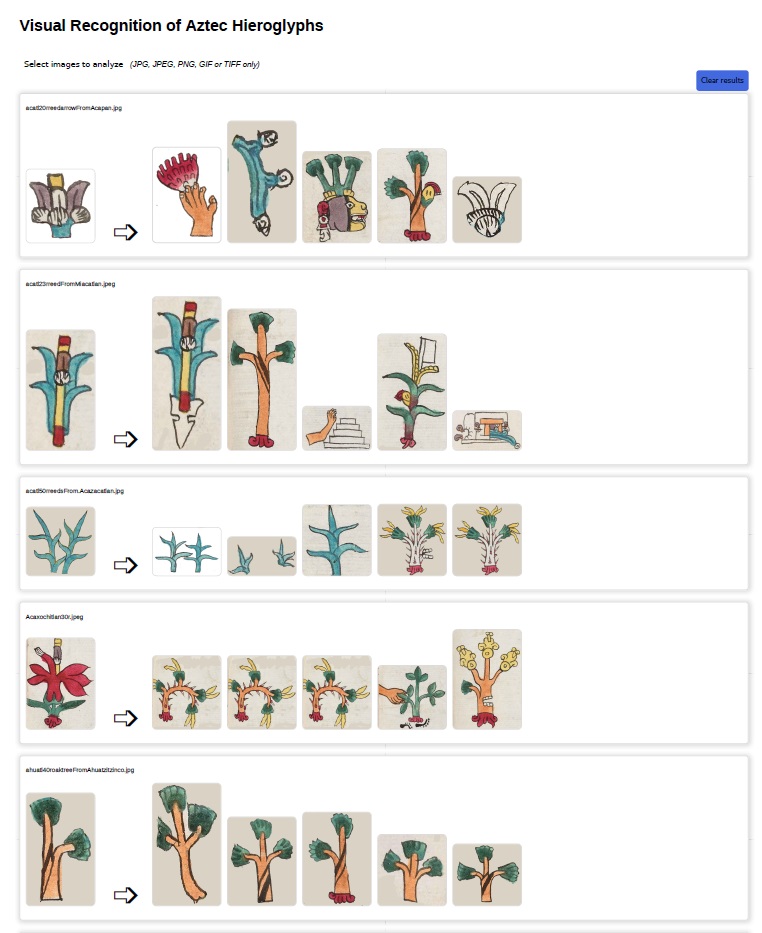
And these are the results using rotated images provided by Tarun
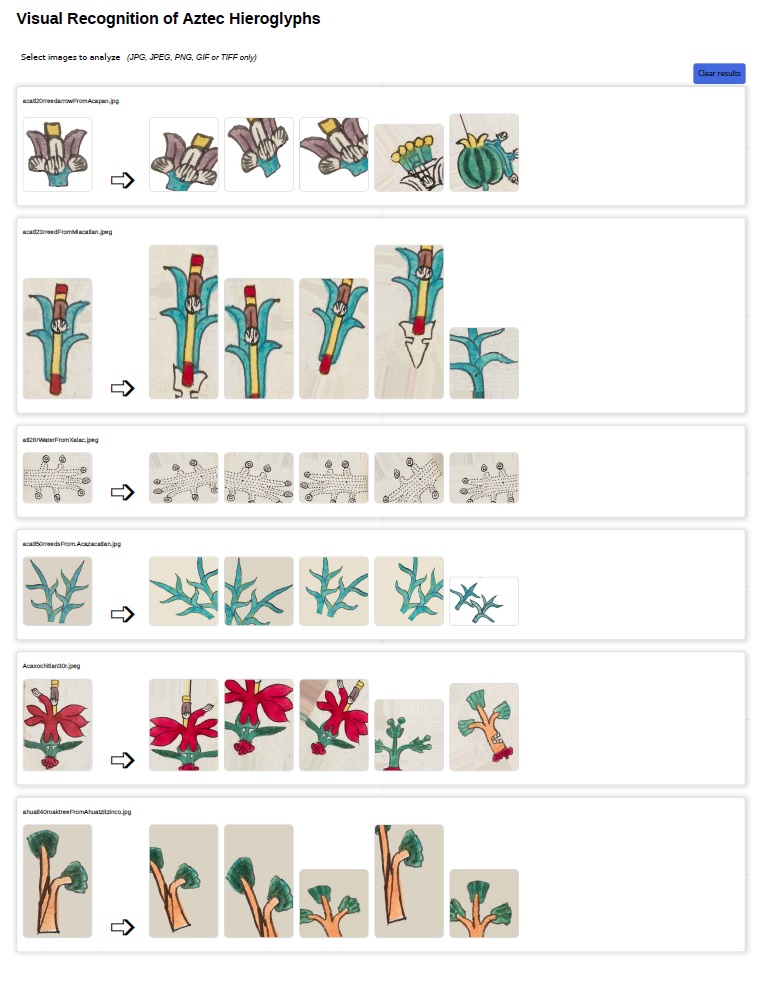
SUCCESS!!!
WEEK 10
9 - 15 AUG
This is the last week. I’m in contact with Stephanie and Tarun for show them my results.
Documentation and final reports.